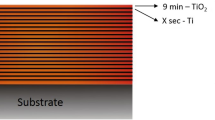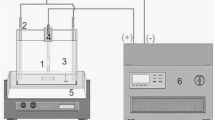Abstract
Introduction
In this work, we report in situ studies of UV photoelectrocatalytic discoloration of a dye (indigo carmine) by a TiO2 thin film in a microreactor to demonstrate the driving force of the applied electrode potential and the dye flow rate toward dye discoloration kinetics.
Methods
TiO2 65-nm-thick thin films were deposited by PVD magnetron sputtering technique on a conducting glass substrate of fluorinated tin oxide. A microreactor to measure the discoloration rate, the electrode potential, and the photocurrent in situ, was developed. The dye solutions, before and after measurements in the microreactor, were analyzed by Raman spectroscopy.
Results
The annealed TiO2 thin films had anatase structure with preferential orientation (101). The discoloration rate of the dye increased with the applied potential to TiO2 electrode. Further, acceleration of the photocatalytic reaction was achieved by utilizing dye flow recirculation to the microreactor. In both cases the photoelectrochemical/photocatalytic discoloration kinetics of the dye follows the Langmuir–Hinshelwood model, with first-order kinetics.
Conclusions
The feasibility of dye discoloration on TiO2 thin film electrodes, prepared by magnetron sputtering using a flow microreactor system, has been clearly demonstrated. The discoloration rate is enhanced by applying a positive potential (E AP) and/or increasing the flow rate. The fastest discoloration and shortest irradiation time (50 min) produced 80% discoloration with an external anodic potential of 0.931 V and a flow rate of 12.2 mL min−1.








Similar content being viewed by others

References
Abadias G, Gago AS, Alonso-Vante N (2011) Structural and photoelectrochemical properties of Ti1−x W x O2 thin films deposited by magnetron sputtering. Surf CoatTechnol 205:S265–S270
Bach U, Lupo D, Comte P, Moser JE, Weissortel F, Salbeck J, Spreitzer H, Grätzel M (1998) Solid-state dye-sensitized mesoporous TiO2 solar cells with high photon-to-electron conversion efficiencies. Nature 395:583–584
Costa LL, Prado AGS (2009) TiO2 nanotubes as recyclable catalyst for efficient photocatalytic degradation of indigo carmine dye. J Photochem Photobiol A: Chem 201:45–49
Cui Y, Du H, Wen L (2009) Enhancement of photoelectrocatalytic properties of stainless-steel/TiO2 electrode by applying mid-frequency electric field. Environ Chem Lett 7:321–324
Ebina T, Iwasaki T, Onodera Y, Hayashi H, Nagase T, Chatterjee A, Chiba K (1999) Ab initio study on the topological Li insertion in titanium oxide. J Power Sources 81–82:393–396
Emeline AV, Ryabchuk V, Serpone N (2000) Factors affecting the efficiency of a photocatalysed process in aqueous metal-oxide dispersions, prospect of distinguishing between two kinetic models. J Photochem Photobiol A: Chem 133:89–97
Hadj Salaha N, Bouhelassaa M, David B (2011) Photocatalytic decoloration of Cibacron Green RG12, on TiO2 fixed on mineral supports by the PMTP method. Phys Procedia 21:115–121
Hagfeldt A, Gräetzel M (1995) Light-induced redox reactions in nanocrystalline systems. Chem Rev 95:49–68
Hepel M, Hazelton S (2005) Photoelectrochemical degradation of diazo dyes on nanostructured electrodes. Electrochim Acta 50:5278–5291
Hepel M, Luo J (2001) Photoelectrochemical mineralization of textile diazo dye pollutants using nanocrystalline WO3 electrodes. Electrochim Acta 47:729–740
Jorge SMA, Sene JJ, Florentino AO (2005) Photoelectrocatalytic treatment of p-nitrophenol using Ti/TiO2 thin-film electrode. J Photochem Photobiol A 174:71–75
Konstantinou IK, Albanis TA (2004) TiO2-assisted photocatalytic degradation of azo dyes in aqueous solution: kinetic and mechanistic investigations: a review. Appl Catal B Environ 49:1–14
Lee SS, Kim HJ, Jung KT, Kim HS, Shul YG (2001) Photocatalytic activity of metal ion (Fe or W) doped titania. Korean J Chem Eng 18:914–918
Li XZ, Li FB, Fan CM, Sun YP (2002) Photoelectrocatalytic degradation of humic acid in aqueous solution using Ti/TiO2 mesh photoelectrode. Water Res 36:2215–2224
Li G, Qu J, Zhang X, Ge J (2006a) Electrochemically assisted photocatalytic degradation of Orange II: influence of initial pH values. J Mol Catal A Chem 259:238–244
Li JQ, Li LP, Zheng L, Xian YZ, Jin LT (2006b) Photoelectrocatalytic degradation of rhodamine B using Ti/TiO2 electrode prepared by laser calcinations method. Electrochim Acta 51:4942–4949
Macedo LC, Zaia DAM, Moore GJ, Santana H (2007) Degradation of leather dye on TiO2: a study of applied experimental parameters on photoelectrocatalysis. J Photochem Photobiol A 185:86–93
Manickam M, Singh P, Issa TB, Thurgate S (2006) Electrochemical behavior of anatase TiO2 in aqueous lithium hydroxide electrolyte. J Appl Electrochem 36:599–602
Nagasawa Y, Taguri R, Matsuda H, Murakami M, Ohama M, Okada T, Miyasaka H (2004) The effect of hydrogen-bonding on the ultrafast electronic deactivation dynamics of indigo carmine. Phys Chem Chem Phys 6:5370–5378
Rull F, Ohtaki H (1997) Raman spectral studies on ionic interaction in aqueous alkali sulfate solutions. Spectrochim Acta A 53:643–653
Sakai N, Fujishima A, Watanabe T, Hashimoto K (2001) Enhancement of the photoinduced hydrophilic conversion rate of TiO2 film electrode surfaces by anodic polarization. J Phys Chem B 105:3023–3026
Seixas de Melo J, Rondao R, Burrows HD, Melo HD, Navaratnam S, Edge R, Voss G (2006) Photophysics of an indigo derivative (keto and leuco structures) with singular properties. J Phys Chem A 110:13653–13661
Shadi IT, Chowdhry BZ, Snowden MJ, Withnall R (2003) Semi-quantitative analysis of indigo carmine, using silver colloids, by surface enhanced resonance Raman spectroscopy (SERRS). Spectrochim Acta A 59:2201–2206
Shadi IT, Chowdhry BZ, Snowden MJ, Withnall R (2004) Analysis of the conversion of indigo into indigo carmine dye using SERRS. Chem Commun 12:1436–1437
Sodergren S, Siegbahn H, Rensmo H, Lindstom H, Hagfeldt A, Lindquist SE (1997) Lithium intercalation in nanoporous anatase TiO2 studied with XPS. J Phys Chem B 101:3087–3090
Torres JD, Faria EA, Souza JR, Prado AGS (2006) Preparation of photoactive chitosan-niobium (V) oxide composites for dye degradation. J Photochem Photobiol A: Chem 182:202–206
Tryk DA, Fujishima A, Honda K (2000) Recent topics in photoelectrochemistry: achievements and future prospects. Electrochim Acta 45:2363–2376
Tsai SJ, Cheng S (1997) Effect of TiO2 crystalline structure in photocatalytic degradation of phenolic contaminants. Catal Today 33:227–237
Turchi CS, Ollis DF (1990) Photocatalytic degradation of organic water contaminants: mechanisms involving hydroxyl radical attack. J Catal 122:178–192
Vautier M, Guillard C, Herrmann J-M (2001) Photocatalytic degradation of dyes in water: case study of indigo and of indigo carmine. J Catal 201:46–59
Wang R, Hashimoto K, Fujishima A, Chikuni M, Kojima E, Kitamura A, Shimohigoshi M, Watanabe T (1997) Light-induced amphiphilic surfaces. Nature 388:431–432
Wang R, Sakai N, Fujishima A, Watanabe T, Hashimoto K (1999) Studies of surface wettability conversion on TiO2 single-crystal surfaces. J Phys Chem B 103:2188–2194
Wang XP, Yu Y, Hu XF, Gao L (2000) Hydrophilicity of TiO2 films prepared by liquid phase deposition. Thin Solid Films 371:148–152
Watanabe T, Nakajima A, Wang R, Minabe M, Koizumi S, Fujishima A, Hashimoto K (1999) Photocatalytic activity and photoinduced hydrophilicity of titanium dioxide coated glass. Thin Solid Films 351:260–263
Zainal Z, Lee CY (2006) Properties and photoelectrocatalytic behaviour of sol–gel derived TiO2 thin films. J Sol-Gel Sci Technol 37:19–25
Zanoni MVB, Sene JJ, Anderson MA (2003) Photoelectrocatalytic degradation of Remazol Brilliant Orange 3R on titanium dioxide thin-film electrodes. J Photochem Photobiol A: Chem 157:55–63
Acknowledgments
The authors wish to thank the partially financial support of this work by a regional Poitou-Charentes project “Aqua Tisol”. C. Montero-Ocampo and A. Gago wish to thank CONACYT (National Council of Science and Technology in Mexico) for the 26389 project financial support and 305477 scholarship, respectively.
Author information
Authors and Affiliations
Corresponding author
Additional information
Responsible editor: Philippe Garrigues
JEP Meeting, Bordeaux, France
Rights and permissions
About this article
Cite this article
Montero-Ocampo, C., Gago, A., Abadias, G. et al. In situ photoelectrochemical/photocatalytic study of a dye discoloration in a microreactor system using TiO2 thin films. Environ Sci Pollut Res 19, 3751–3762 (2012). https://doi.org/10.1007/s11356-012-0771-x
Received:
Accepted:
Published:
Issue Date:
DOI: https://doi.org/10.1007/s11356-012-0771-x



